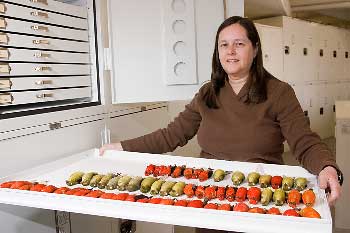Pickled birds, bird eggs, bird nests, bird tissue, bird skeletons and stuffed skins. No, these aren’t items on the menu at a French restaurant. They are the objects included in the research collection of the U-M Museum of Zoology Bird Division.

Janet Hinshaw, collection manager for the Bird Division, is in charge of preparing and documenting all the research specimens that enter the collection. The birds that are acquired have died of natural causes, and are collected by the museum for research purposes.
Hinshaw most often uses the birds for their skins or for their skeletons. The former process involves emptying out the birds’ insides and filling them with cotton, while the latter requires Hinshaw to put the dead birds into a tank of hungry beetles so that in a period of 24 hours only their bones will be left.
She then documents as much information as possible about the birds in a highly organized computerized database that can be found on the division’s Web site.
The collection consists of more than 200,000 specimens, with almost 500 more added every year. Curators and graduate students from many different universities and fields use the specimens for DNA research, dissection and observation, as they are part of the largest collection of Michigan birds in the world, and the largest assortment of bird bones in the world.
“A lot of people are interested in global warming, habitat destruction and other environmental changes. You can use the specimens to study these changes and the distribution of species,” Hinshaw says.
She also notes that birds often are used for research “because they’re easy to see and easy to count and there are a lot of people into bird watching so there’s a lot of information available on them.”
Although in the past the museum bought many of its specimens, most of them today are local birds that have died running into windshields or windows and have been put in the collection instead of the trash can.
At first glance, the environment of the Bird Division looks like a library. In fact, very standard-looking file cabinets are occupied by rows of stuffed birds of every species. From tiny South American hummingbirds to a 19th century ostrich skin, the collection has it all. It even contains a stuffed Labrador duck, an extinct species so rare in museum collections that Hinshaw isn’t quite sure how it came into the museum’s possession.
“Some of the oldest specimens were collected when Michigan first became a state. The legislature hired a man to survey the natural resources of Michigan, so we have some of those specimens that he collected,” she says.
Hinshaw always has been interested in animals, and she learned how to stuff birds at Earlham College in Richmond, Ind., where she received her undergraduate degree in biology. She also is an avid birdwatcher, as evidenced by the telescope erected in front of a northwest window in the room in which the collection resides, where she has a clear view of the Burton Bell Tower.
Last summer, two peregrine falcons, formerly an endangered species, nested in the tower. Peregrines are noted for nesting on bridges, bell towers and tall buildings and traveling long distances. Although they did not successfully produce any offspring, Hinshaw enjoyed watching them, and says they “were probably raised on a bell tower and so they liked it when they saw it on Michigan’s campus.”
Aside from working as the collection manager for the museum and bird watching in her spare time, Hinshaw also is the librarian for the Wilson Ornothological Society, where she organizes journals and books rather than birds.

